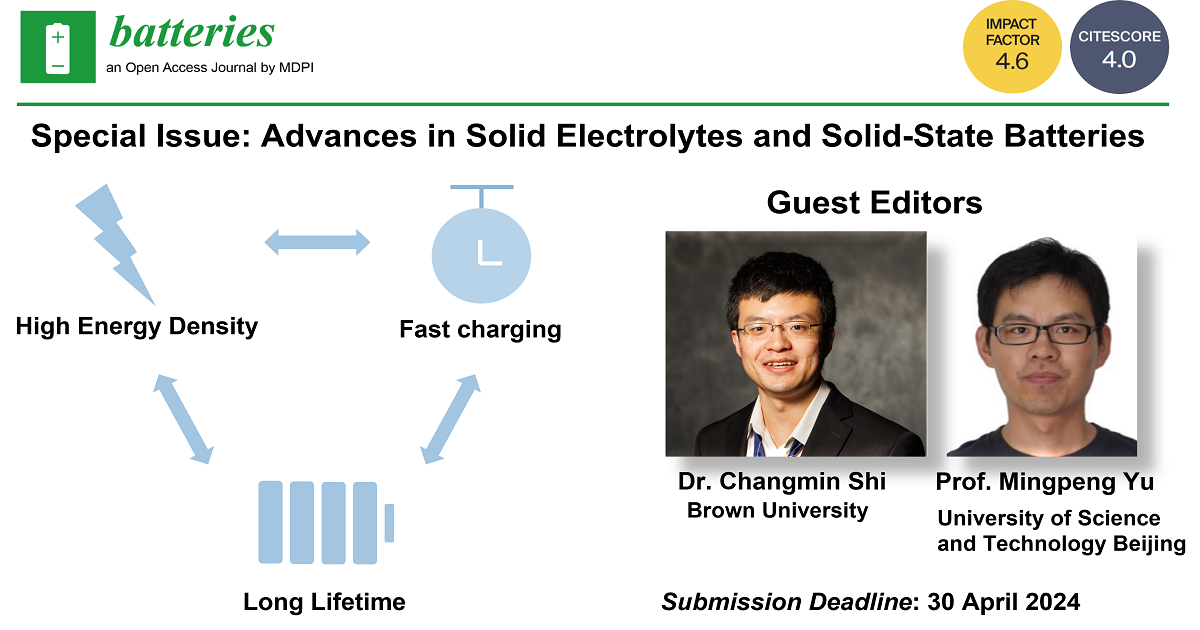- 4.8Impact Factor
- 6.6CiteScore
- 19 daysTime to First Decision
Advances in Solid Electrolytes and Solid-State Batteries
This special issue belongs to the section “Battery Materials and Interfaces: Anode, Cathode, Separators and Electrolytes or Others“.
Special Issue Information
Dear Colleagues,
Rechargeable batteries are becoming increasingly attractive for promoting a fossil fuel-free world. Current commercialized Li-ion batteries have a variety of cathodes and anodes, but they almost exclusively employ liquid electrolyte (LE). These highly flammable organic electrolytes are the primary safety concern. The most commonly cited battery systems that promise to deliver improved safety and increased energy density are those with a pure Li metal anode and a solid electrolyte (SE) to form a solid-state battery (SSB). Despite their potential, SSBs face critical challenges. Lithium dendrite growth through the SE can lead to battery failure due to electrical shorting, and unstable interactions at the cathode/SE interface can cause rapid capacity decay. These issues significantly hamper the further development and commercialization of SSB technology.
Therefore, the focus of the present Special Issue, entitled “Advances in Solid Electrolytes and Solid-State Batteries,” is twofold. First, it seeks to explore the design of high-performance SSBs, leveraging the latest advances in materials science and engineering. Second, it aims to deepen the understanding of the electrolyte/electrode interface properties and the mechanisms underlying SSB failure. By addressing these critical areas, this Special Issue contributes to the ongoing efforts to overcome the current limitations and unlock the full potential of SSB technology for a more sustainable and safer energy future.
Dr. Changmin Shi
Dr. Mingpeng Yu
Guest Editors
Manuscript Submission Information
Manuscripts should be submitted online at www.mdpi.com by registering and logging in to this website. Once you are registered, click here to go to the submission form. Manuscripts can be submitted until the deadline. All submissions that pass pre-check are peer-reviewed. Accepted papers will be published continuously in the journal (as soon as accepted) and will be listed together on the special issue website. Research articles, review articles as well as short communications are invited. For planned papers, a title and short abstract (about 250 words) can be sent to the Editorial Office for assessment.
Submitted manuscripts should not have been published previously, nor be under consideration for publication elsewhere (except conference proceedings papers). All manuscripts are thoroughly refereed through a single-blind peer-review process. A guide for authors and other relevant information for submission of manuscripts is available on the Instructions for Authors page. Batteries is an international peer-reviewed open access monthly journal published by MDPI.
Please visit the Instructions for Authors page before submitting a manuscript. The Article Processing Charge (APC) for publication in this open access journal is 2700 CHF (Swiss Francs). Submitted papers should be well formatted and use good English. Authors may use MDPI's English editing service prior to publication or during author revisions.
Keywords
- solid electrolyte
- electrolyte–electrode interface
- solid-state battery
- high energy density
- battery mechanics
- solid-state battery failure

Benefits of Publishing in a Special Issue
- Ease of navigation: Grouping papers by topic helps scholars navigate broad scope journals more efficiently.
- Greater discoverability: Special Issues support the reach and impact of scientific research. Articles in Special Issues are more discoverable and cited more frequently.
- Expansion of research network: Special Issues facilitate connections among authors, fostering scientific collaborations.
- External promotion: Articles in Special Issues are often promoted through the journal's social media, increasing their visibility.
- e-Book format: Special Issues with more than 10 articles can be published as dedicated e-books, ensuring wide and rapid dissemination.

